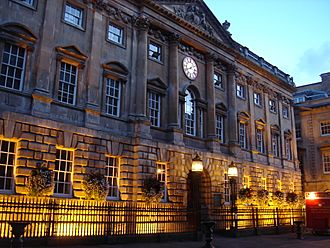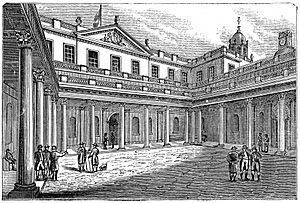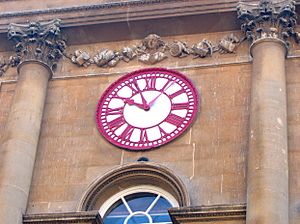The Exchange, Bristol facts for kids
Quick facts for kids The Exchange |
|
|---|---|

The Exchange at dusk
|
|
| General information | |
| Architectural style | Georgian Palladian |
| Town or city | Bristol |
| Country | England |
| Coordinates | 51°27′16″N 2°35′37″W / 51.4544°N 2.5935°W |
| Construction started | 1741 |
| Completed | 1743 |
| Design and construction | |
| Architect | John Wood the Elder |
|
Listed Building – Grade I
|
|
| Official name: The Exchange | |
| Designated: | 8 January 1959 |
| Reference #: | 1298770 |
The Exchange is a very old and important building in Bristol, England. It was built between 1741 and 1743 by a famous architect named John Wood the Elder. You can find it on Corn Street, close to Broad Street.
This building was once a busy place where people traded things like corn. Today, it holds offices and is home to the lively St Nicholas Market. Over the years, The Exchange has had some big changes. For example, in 1872, a roof was added over its central courtyard. After World War II, the clock tower on the outside was taken down, and the roof was made lower.
Outside the building, you'll see four special bronze tables. They are from the 16th and 17th centuries and are called "nails." Merchants used these tables to do their business deals. At the front of The Exchange, there's a clock with two minute hands. One shows the local time in Bristol, and the other shows Greenwich Mean Time.
The Story of The Exchange
The Exchange was built by John Wood the Elder between 1741 and 1743. The detailed carvings were made by Thomas Paty. John Wood also designed another exchange building in Liverpool, but it was destroyed by fire. The London Exchange of that time also burned down. This means Bristol's Exchange is special because it's the only 18th-century exchange building left in England!
When it was finished in 1743, The Exchange looked like one grand building from the outside. Its front still looks much the same today. It has tall Corinthian columns in the middle and flat columns, called pilasters, on the sides. The main entrance has lion-head door knockers made of cast iron. Above the door, there's a decorated strip, or frieze, with human and animal heads. These heads represent trade. You can also see the Royal Coat of Arms in the triangular space above the entrance, called the tympanum. The back of the building is also neatly designed with windows that have triangular tops and arched openings on the ground floor.
Inside, The Exchange had many different areas. Near the front entrance, there was a coffeehouse and a tavern, both with four floors. Above and below the main entrance were strong rooms, like bank vaults. In the middle of the building was an open court with columns all around it. At the back, there was an arcade on the ground floor and a long room on the first floor. There were also houses for business people and cellars underneath.
In 1872, a lot of building work was done, designed by Edward Middleton Barry. This included adding a roof over the central court. New offices were also built on the first floor around the court.
The building's use as a place for farming trade went down a lot in the late 1800s. More big changes happened in the early 1900s when the City Valuer's Department moved in. They added an elevator from the basement to the first floor. Since 1945, the roof over the central court has been replaced, and the clock tower at the back was removed.
The Exchange was built for all kinds of merchants. Some of these merchants were involved in the Bristol slave trade, which was a sad part of Bristol's history. Inside the main hall, the plasterwork shows figures from different parts of the world, including Africa and America. These figures were symbols of Bristol's trade with other countries.
In the 1960s, The Exchange became a popular place for concerts. Famous bands like The Rolling Stones, The Who, The Spencer Davis Group, and Cream all played there!
Today, The Exchange is a very important historical building, known as a Grade I listed building. It has always belonged to the City of Bristol. It is now used for offices, including those for market traders and the Joint Trade Unions Safety Office.
The Bronze "Nails"
You can see four special bronze tables, called "nails," outside The Exchange on Corn Street. They were probably made to be like portable tables that merchants would take to markets. Before The Exchange was built, these "nails" were in an area called the Tolzey Walk. This was a covered path along the wall of All Saints Church.
These bronze "nails" have flat tops and raised edges to stop coins from falling off. They were perfect for merchants to do their business deals. The oldest "nail" doesn't have a date, but experts think it's from the late 1500s. The second oldest was given by a Bristol merchant named Robert Kitchin, who died in 1594. The other two "nails" are dated 1625 and 1631.
Since they were made at different times, the "nails" have different designs. One of them has the name John Barker on its edge. John Barker was a rich merchant who owned many properties in Bristol. He was also the mayor during the time of King Charles I.
People say that the saying "pay on the nail" or "cash on the nail" comes from merchants paying their debts on these tables. However, some people disagree about where this saying really came from.
The Special Clock
The clock on The Exchange was first put there in 1822. Later, a second minute hand was added. This was so the clock could show both the local time in Bristol and the time in London. The red minute hand shows Bristol time, and the pink one shows Greenwich Mean Time.
This became important when railways started to become popular. Trains needed a standard time across the whole country for their schedules. This was called railway time. Bristol officially started using railway time on September 14, 1852. Bristol is a bit west of Greenwich, so when it was noon in Bristol by the old local time, it was already a little after 12:10 p.m. in London by the standard time.




